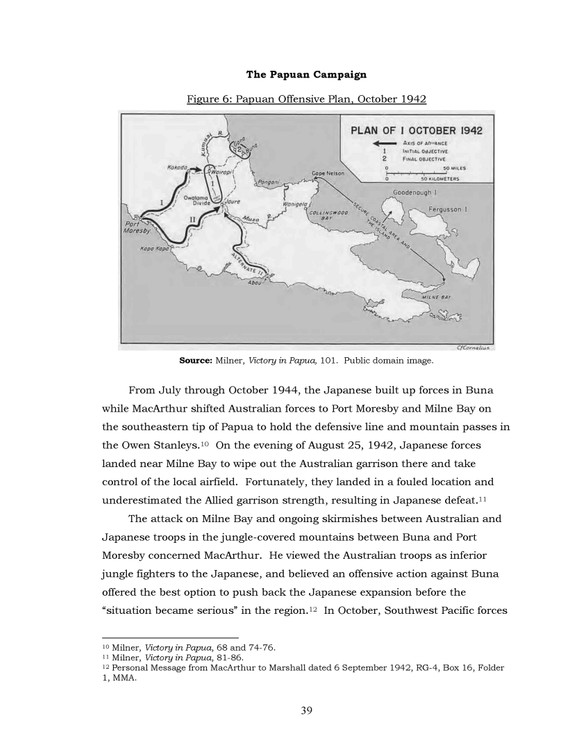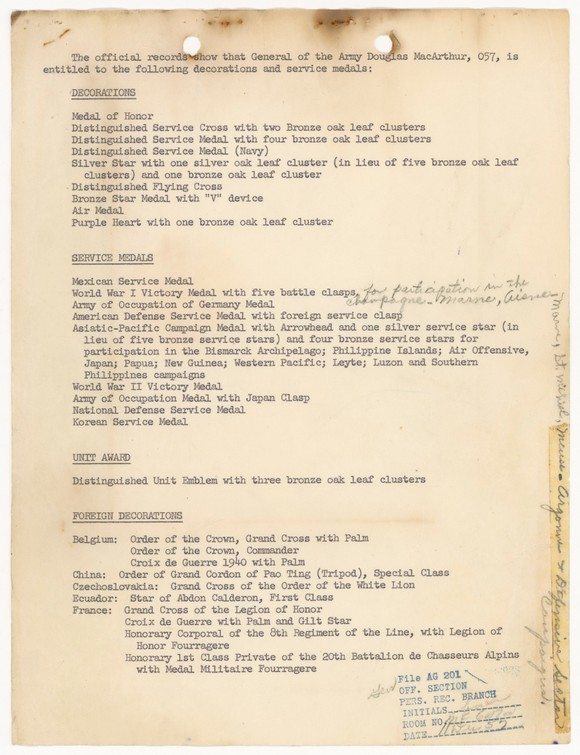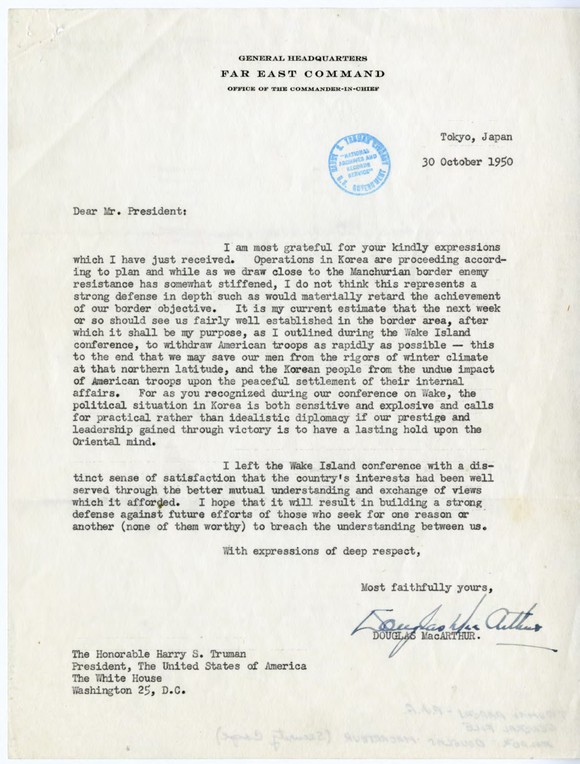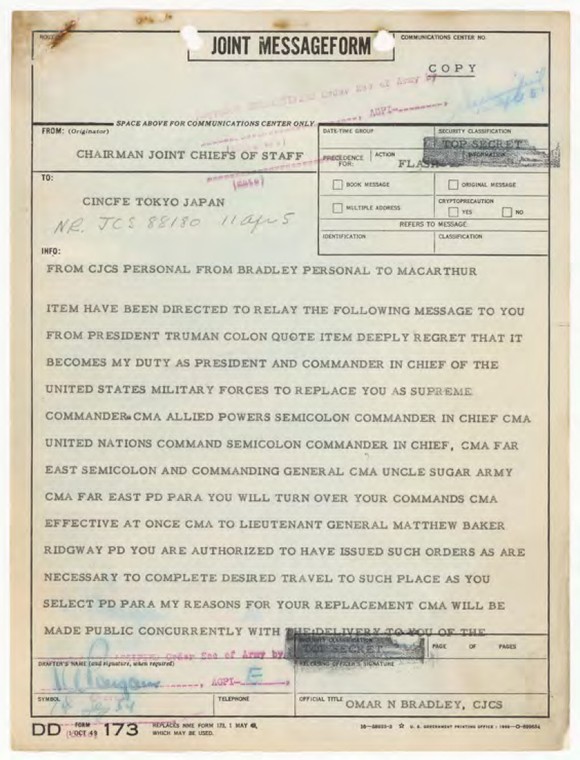Starting from:
$14.95
General Douglas MacArthur Military Records, Histories, FBI Files, Truman Papers
General Douglas MacArthur Military Records, Academic Studies, FBI Files, Truman Papers and Historical Documents.
6,931 pages of Military Records, Academic Records, FBI Files, Truman Papers and Historical Documents related to Douglas MacArthur.
Douglas MacArthur (1880-1964) was born in Arkansas, the son of Army Captain Arthur MacArthur. He graduated from the U.S. Military Academy at West Point in 1903, over the next decade and a half he was assigned to Army posts in the U.S., the Philippines and Panama, served at the War Department and participated in the occupation of Vera Cruz, Mexico. During World War I, MacArthur saw combat in France, commanding the 42nd ("Rainbow") Division with the temporary rank of Brigadier General. Following the war, he was named Superintendent of the Military Academy and served two tours of duty in the Philippines.
Appointed Chief of Staff of the Army in 1930, with the rank of General, MacArthur remained in that post until 1935. He then went back to the Philippines, charged with creating a Filipino army. General MacArthur retired from the U.S. Army in 1937 and was appointed to the rank of Field Marshall in the Philippine Army. As the threat of war with Japan grew, in July 1941 he was recalled to U.S. service as commander of U.S. Army Forces in the Far East, initially in the rank of Lieutenant General. After Japan began hostilities in December 1941, he was responsible for U.S. and Philippines forces in their unsuccessful fight against the Japanese, later receiving the Medal of Honor in recognition of his efforts.
At the order of President Franklin D. Roosevelt, General MacArthur was evacuated from the Philippines in March 1942. Given command of Allied forces in the Southwest Pacific area, he directed the successful defense of southeastern New Guinea, and beginning later in 1942, the counteroffensive that ultimately swept the Japanese from the region, leading to his return to the Philippines with the October 1944 invasion of Leyte. Promoted to General of the Army shortly before the end of 1944, MacArthur subsequently oversaw the liberation of the rest of the Philippines. After Japan surrendered in August 1945 General MacArthur presided over the formal surrender ceremonies and, during the next five years, was responsible for demilitarizing Japan and reforming its political and economic life.
Beginning late June 1950, when North Korea began the Korean War, MacArthur oversaw the United Nations' forces. Success against the North Koreans was followed, in November 1950, by a vigorous Chinese intervention, which was also largely contained by the spring of 1951. However, by that time General MacArthur's outspoken views had made him unacceptable to the Truman Administration. In April 1951 he was relieved of his commands and recalled to the United States, where he received a hero's welcome. After an abortive run for the Presidency in 1951-1952, he spent the rest of his life as an elder statesman for conservative and nationalist causes. MacArthur died on 5 April 1964.
This collection includs:
Official Military Personnel File
4,147 pages of Douglas MacArthur's official military personnel file. This Official Military Personnel File includes records from the following folders: Service Documents (June 1903-July 1964); Correspondence (March 1918-September 1977); Awards, Decorations, & Commendations (March 1918-September 1964); Efficiency/Fitness Reports (1904-1945); Medical Records (November 1900-August 1964); Photographs & Negatives.
President Harry S Truman Papers
138 pages of Truman papers including correspondences, memorandum, hand written notes by Truman and newspaper clippings documenting the relationship between MacArthur and the Truman Administration, focusing on issues surrounding Truman reliving MacArthur of his command.
Reports of General MacArthur
Campaigns of MacArthur in the Pacific, Vol. I, Japanese Operations in the Southwest Pacific Area, Vol. II, Part I, Japanese Operations in the Southwest Pacific Area, Vol. II, Part II and MacArthur in Japan: The Occupation: Military Phase, Vol. I Supplement.
1,680 pages in four volumes of Reports of General MacArthur. The official after-action reports of General of the Army Douglas MacArthur. Contains not only MacArthur's own perspective of his operations against the Japanese in the Southwest Pacific Area during World War II, but also the opposition's unique account of Imperial Army campaigns against MacArthur's forces. Collectively, the reports have substantial and enduring value for military historians and students of military affairs, providing an illuminating record of momentous events influenced in large measure by MacArthur.
FBI Files
149 pages of General Douglas McArthur FBI Files.
CIA Journal Studies in Intelligence
An Article from the CIA's journal Studies in Intelligence titled, "General MacArthur and the OSS, 1942-1945."
Military Academic Studies
803 pages of military academic studies covering the military career of General Douglas MacArthur. Reports include:
The Role of the Operational Artist: General MacArthur in the Korean War from June 1950 to April 1951 (2019)
A thesis by Major Brandon E. Pasko. This study applies the theory of the operational artist to evaluate General Douglas MacArthur's command in the Korean War to illuminate considerations in regards to a senior military commanders authority to discuss policy and negotiate military strategy with policymakers and their responsibility to operate within the constraints imposed by policy to achieve the political aim, through the military aim.
General of the Army Douglas Macarthur: Considerations for Modern Joint Force Commanders (2017)
A Thesis by Major Brett J. Cassidy. This study evaluates current US military joint doctrine specific to Joint Force Commanders through historical analysis of General of the Army Douglas MacArthur during his tenure as the Supreme Commander of Southwest Pacific Area forces in World War II from 1942-1945.
Truman and MacArthur The Winding Road to Dismissal (2006)
A monograph by Michael D. Pearlman, Ph.D., Combat Studies Institute, U.S. Army Command and General Staff College.
The Operational Leadership of General Douglas MacArthur in OPERATION CHROMITE (2002)
A paper by Judie A. Heineman Commander, United States Navy. This study exams the traits that are essential for the twenty-first century joint warfighter. The writer holds that General MacArthur demonstrated these traits in formulating the plans for OPERATION CHROMITE, the amphibious assault at Inchon in Korea in 1950. By analyzing how each of these traits was demonstrated in this operation, the joint warfighter can use a practical example to reinforce this theory.
Douglas MacArthur Upon Reflection (1998)
A research report by Lowell L. Snitchler, Col, USAF.
Abstract: General-of-the-Army Douglas MacArthur was a complex man whose behaviors seem contradictory on the surface. In fact, he demonstrated an enduring pattern of perceiving, relating to, and thinking about himself and his environment. This consistent personality is evident across a wide range of social and personal contexts and can be traced back to his developmental childhood and adolescent years. This research recounts MacArthur’s personality development from childhood, investigates his last military campaign, and, finally, applies the diagnosis of narcissistic personality disorder to the assembled data. Upon reflection, MacArthur’s apparent behavioral inconsistencies are reconciled within this clinical framework. Finally, organizational, heuristic and predictive implications are drawn from this research.
The Truman-MacArthur Tug of War - A Lingering Aftermath (1993)
A paper by Stephen A. Danner Lieutenant Colonel. This paper briefly reviews the public disagreement between President Truman and General MacArthur over civilian control of the military, the strategic direction of the Korean war, and the political overtones of their clash. Additionally, it examines the aftermath of MacArthur’s relief.
An Analysis of the Military Strategy of Douglas MacArthur (1984)
A report by William B. Martin, Major, USAF. Presents a brief overview of the life and career of General of the Army Douglas MacArthur. The report contains biographical data and follows his rise to command. The project looks at some of MacArthur’s contributions while he was Chief of Staff of the Army and concludes by analyzing his World War II and Korean Conflict strategies in the context of the ACSC Strategy Process Model.
The Truman-MacArthur controversy, A Study in Political-Military Relations (1972)
A paper by Allen R. Potter, Lieutenant Colonel.
Abstract: The purpose of this paper is to determine the political-military relationship between the Truman Administration and General of the Army Douglas MacArthur during the Korean War. Particular attention was directed to those factors resulting in the relief of General MacArthur in April of 1951. The study was conducted through the medium of library research to include a search of the official documents on this subject at the Harry S. Truman Library and the use of a draft manuscript on the subject from the Office of the Chief of Military History, U.S. Amy.











6,931 pages of Military Records, Academic Records, FBI Files, Truman Papers and Historical Documents related to Douglas MacArthur.
Douglas MacArthur (1880-1964) was born in Arkansas, the son of Army Captain Arthur MacArthur. He graduated from the U.S. Military Academy at West Point in 1903, over the next decade and a half he was assigned to Army posts in the U.S., the Philippines and Panama, served at the War Department and participated in the occupation of Vera Cruz, Mexico. During World War I, MacArthur saw combat in France, commanding the 42nd ("Rainbow") Division with the temporary rank of Brigadier General. Following the war, he was named Superintendent of the Military Academy and served two tours of duty in the Philippines.
Appointed Chief of Staff of the Army in 1930, with the rank of General, MacArthur remained in that post until 1935. He then went back to the Philippines, charged with creating a Filipino army. General MacArthur retired from the U.S. Army in 1937 and was appointed to the rank of Field Marshall in the Philippine Army. As the threat of war with Japan grew, in July 1941 he was recalled to U.S. service as commander of U.S. Army Forces in the Far East, initially in the rank of Lieutenant General. After Japan began hostilities in December 1941, he was responsible for U.S. and Philippines forces in their unsuccessful fight against the Japanese, later receiving the Medal of Honor in recognition of his efforts.
At the order of President Franklin D. Roosevelt, General MacArthur was evacuated from the Philippines in March 1942. Given command of Allied forces in the Southwest Pacific area, he directed the successful defense of southeastern New Guinea, and beginning later in 1942, the counteroffensive that ultimately swept the Japanese from the region, leading to his return to the Philippines with the October 1944 invasion of Leyte. Promoted to General of the Army shortly before the end of 1944, MacArthur subsequently oversaw the liberation of the rest of the Philippines. After Japan surrendered in August 1945 General MacArthur presided over the formal surrender ceremonies and, during the next five years, was responsible for demilitarizing Japan and reforming its political and economic life.
Beginning late June 1950, when North Korea began the Korean War, MacArthur oversaw the United Nations' forces. Success against the North Koreans was followed, in November 1950, by a vigorous Chinese intervention, which was also largely contained by the spring of 1951. However, by that time General MacArthur's outspoken views had made him unacceptable to the Truman Administration. In April 1951 he was relieved of his commands and recalled to the United States, where he received a hero's welcome. After an abortive run for the Presidency in 1951-1952, he spent the rest of his life as an elder statesman for conservative and nationalist causes. MacArthur died on 5 April 1964.
This collection includs:
Official Military Personnel File
4,147 pages of Douglas MacArthur's official military personnel file. This Official Military Personnel File includes records from the following folders: Service Documents (June 1903-July 1964); Correspondence (March 1918-September 1977); Awards, Decorations, & Commendations (March 1918-September 1964); Efficiency/Fitness Reports (1904-1945); Medical Records (November 1900-August 1964); Photographs & Negatives.
President Harry S Truman Papers
138 pages of Truman papers including correspondences, memorandum, hand written notes by Truman and newspaper clippings documenting the relationship between MacArthur and the Truman Administration, focusing on issues surrounding Truman reliving MacArthur of his command.
Reports of General MacArthur
Campaigns of MacArthur in the Pacific, Vol. I, Japanese Operations in the Southwest Pacific Area, Vol. II, Part I, Japanese Operations in the Southwest Pacific Area, Vol. II, Part II and MacArthur in Japan: The Occupation: Military Phase, Vol. I Supplement.
1,680 pages in four volumes of Reports of General MacArthur. The official after-action reports of General of the Army Douglas MacArthur. Contains not only MacArthur's own perspective of his operations against the Japanese in the Southwest Pacific Area during World War II, but also the opposition's unique account of Imperial Army campaigns against MacArthur's forces. Collectively, the reports have substantial and enduring value for military historians and students of military affairs, providing an illuminating record of momentous events influenced in large measure by MacArthur.
FBI Files
149 pages of General Douglas McArthur FBI Files.
CIA Journal Studies in Intelligence
An Article from the CIA's journal Studies in Intelligence titled, "General MacArthur and the OSS, 1942-1945."
Military Academic Studies
803 pages of military academic studies covering the military career of General Douglas MacArthur. Reports include:
The Role of the Operational Artist: General MacArthur in the Korean War from June 1950 to April 1951 (2019)
A thesis by Major Brandon E. Pasko. This study applies the theory of the operational artist to evaluate General Douglas MacArthur's command in the Korean War to illuminate considerations in regards to a senior military commanders authority to discuss policy and negotiate military strategy with policymakers and their responsibility to operate within the constraints imposed by policy to achieve the political aim, through the military aim.
General of the Army Douglas Macarthur: Considerations for Modern Joint Force Commanders (2017)
A Thesis by Major Brett J. Cassidy. This study evaluates current US military joint doctrine specific to Joint Force Commanders through historical analysis of General of the Army Douglas MacArthur during his tenure as the Supreme Commander of Southwest Pacific Area forces in World War II from 1942-1945.
Truman and MacArthur The Winding Road to Dismissal (2006)
A monograph by Michael D. Pearlman, Ph.D., Combat Studies Institute, U.S. Army Command and General Staff College.
The Operational Leadership of General Douglas MacArthur in OPERATION CHROMITE (2002)
A paper by Judie A. Heineman Commander, United States Navy. This study exams the traits that are essential for the twenty-first century joint warfighter. The writer holds that General MacArthur demonstrated these traits in formulating the plans for OPERATION CHROMITE, the amphibious assault at Inchon in Korea in 1950. By analyzing how each of these traits was demonstrated in this operation, the joint warfighter can use a practical example to reinforce this theory.
Douglas MacArthur Upon Reflection (1998)
A research report by Lowell L. Snitchler, Col, USAF.
Abstract: General-of-the-Army Douglas MacArthur was a complex man whose behaviors seem contradictory on the surface. In fact, he demonstrated an enduring pattern of perceiving, relating to, and thinking about himself and his environment. This consistent personality is evident across a wide range of social and personal contexts and can be traced back to his developmental childhood and adolescent years. This research recounts MacArthur’s personality development from childhood, investigates his last military campaign, and, finally, applies the diagnosis of narcissistic personality disorder to the assembled data. Upon reflection, MacArthur’s apparent behavioral inconsistencies are reconciled within this clinical framework. Finally, organizational, heuristic and predictive implications are drawn from this research.
The Truman-MacArthur Tug of War - A Lingering Aftermath (1993)
A paper by Stephen A. Danner Lieutenant Colonel. This paper briefly reviews the public disagreement between President Truman and General MacArthur over civilian control of the military, the strategic direction of the Korean war, and the political overtones of their clash. Additionally, it examines the aftermath of MacArthur’s relief.
An Analysis of the Military Strategy of Douglas MacArthur (1984)
A report by William B. Martin, Major, USAF. Presents a brief overview of the life and career of General of the Army Douglas MacArthur. The report contains biographical data and follows his rise to command. The project looks at some of MacArthur’s contributions while he was Chief of Staff of the Army and concludes by analyzing his World War II and Korean Conflict strategies in the context of the ACSC Strategy Process Model.
The Truman-MacArthur controversy, A Study in Political-Military Relations (1972)
A paper by Allen R. Potter, Lieutenant Colonel.
Abstract: The purpose of this paper is to determine the political-military relationship between the Truman Administration and General of the Army Douglas MacArthur during the Korean War. Particular attention was directed to those factors resulting in the relief of General MacArthur in April of 1951. The study was conducted through the medium of library research to include a search of the official documents on this subject at the Harry S. Truman Library and the use of a draft manuscript on the subject from the Office of the Chief of Military History, U.S. Amy.











2 files (885.6MB)



